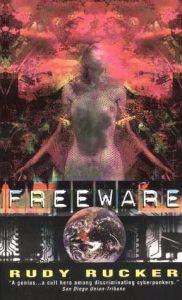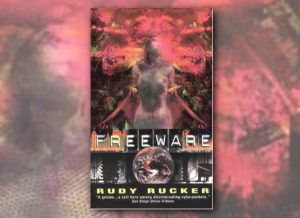FREEWARE by Rudy Rucker (BOOK REVIEW)
“All my Silly Putters have turned into fucked-up aliens. They’ve been taken over by some kind of rogue software from outer space – I didn’t ask for it, but here it is, and it’s free, whether we want it or not, it’s physical graffiti from dimension Z, the truest freeware there ever was.”
 The previous two books in the Ware tetralogy, Software (1982) and Wetware (1988), explored Rudy Rucker’s ideas around uploading human consciousness and implanting robot consciousness into human bodies. Freeware (1997), the third book in the series, is a further exploration of the posthuman condition. Rucker transports us to a world in which shapeshifting robots have changed the way humans think about embodiment and sexuality, and solving the mathematical puzzles of the universe allows the consciousness of aliens to be decoded from cosmic radiation. Welcome to another delightful Rucker novel, where once again gonzo humour, advanced mathematics, surrealism and Alice In Wonderland collide to create a heady cyberpunk classic.
The previous two books in the Ware tetralogy, Software (1982) and Wetware (1988), explored Rudy Rucker’s ideas around uploading human consciousness and implanting robot consciousness into human bodies. Freeware (1997), the third book in the series, is a further exploration of the posthuman condition. Rucker transports us to a world in which shapeshifting robots have changed the way humans think about embodiment and sexuality, and solving the mathematical puzzles of the universe allows the consciousness of aliens to be decoded from cosmic radiation. Welcome to another delightful Rucker novel, where once again gonzo humour, advanced mathematics, surrealism and Alice In Wonderland collide to create a heady cyberpunk classic.
Freeware picks up some twenty years after the events of Wetware. The infestation of the boppers with chipmold has led to the evolution of moldies, artificial lifeforms made of soft plastic imipolex and fungus. Relations between the humans and the moldies are as fraught as their paranoid and xenophobic reactions to the boppers and the meatbops previously, but thanks to good old Stahn Mooney’s Moldie Citizenship Act, moldies can live and work on Earth. The reactionary Heritagists want to burn them, the sleazy cheeseballs want to have sex with them, but otherwise moldies like Monique can work in a San Francisco motel, saving up to buy enough imipolex to create offspring or build replacement bodies for themselves. That is until Kentucky cheeseball Randy Karl Tucker kidnaps Monique and sends her to the moon, setting off a series of events which will culminate in a breakthrough in imipolex design being used to download freeware alien consciousness coded in cosmic rays, aliens whose advent could mean the end of human and moldie civilisation. All of which means it’s time for ex-senator Stahn Mooney and the recorded consciousness of Cobb Anderson, inventor of the boppers, to come out of retirement.
If Wetware saw Rucker embracing some of the more traditional aesthetics of the cyberpunk peers, Freeware sees him marching to no one’s beat but his own. From surfing to the Jabberwocky, from Salvador Dali to aliens who experience two dimensions of time, the book is a glorious mishmash of classic Rucker-esque material. The novel’s narrative is considerably more complex than that of Software and Wetware as well, featuring multiple viewpoint characters and a non-linear narrative that all comes together in the end. Stahn and Cobb take on more of a supporting role this time round, allowing Darla and Willy from Wetware and new characters Monique, Randy, Tre and Terry to take the stage. This gives Freeware a more expansive feel than the previous two books, and the profusion of different viewpoints, especially of female characters and moldie characters, gives the novel a more rounded feel. Similarly, the book benefits from a sequence set in Bangalore, as well as Rucker’s traditional California and the Moon. One can see Rucker’s development as a writer.
Technology was also developing in between the release of Wetware and Freeware, and the cyberpunk concern of digital technology becoming a part of reality was on the horizon. In Freeware, Rucker anticipates much of the way in which internet technology would alter the feel of the world, if not the actual technology used to do it. People use telerobots, “remotely controlled mobile camera eyes”, in essence miniaturised drones, to record videos of family and friends, and the news corporations use them for reporting. Much human and moldie interaction is built around constructing individual programmable units that can be set to any desired function. These wind up replacing conventional silicon chips on Earth and the Moon after all the old style technology is destroyed by the chipmold. People record themselves using the ceaseless global interactive multiuser stunglasses Show, and broadcast the footage to thousands of virtual followers. While the internet was already in full flow by the time Rucker was writing Freeware, innovations like drones and social media were still just on the horizon. The novel is a good example of how cyberpunk is a particularly fruitful genre for anticipating the way new technologies will change the fabric of our lives.
At its heart, like Software and Wetware, Freeware is a celebration of biological and mechanical chaos, and the drivers that bring them together to create startling and unexpected results. The moldies share much of the boppers’ eccentric charisma, but with their ability to change shape at will offer another challenge to traditional conceptions of embodiment. This is echoed in all of the gloriously bizarre aliens, displaying a wealth of strange and different ways of being within the universe, all fascinating. Similarly the moldies and the internet open up a whole new range of ways in which humans and moldies can explore their sexualities, none of them tied to conservative understandings of gendered embodiment. As Stahn says,
“Sri Ramanujan at Emperor Staghorn Beetle Larvae, Ltd., is working on some new method for bringing humans and moldies closer together. He won’t give our any details, but its bound to be a force for good, the way I look at it. Humans and moldies were meant to be one.”
Stahn and his friends and allies are all for celebrating humanity and personhood in whatever shapes or forms they come in, and revelling in the excitement and chaos that comes of bringing them all together. This celebration of the diversity of existence lies at the heart of the Ware books.

